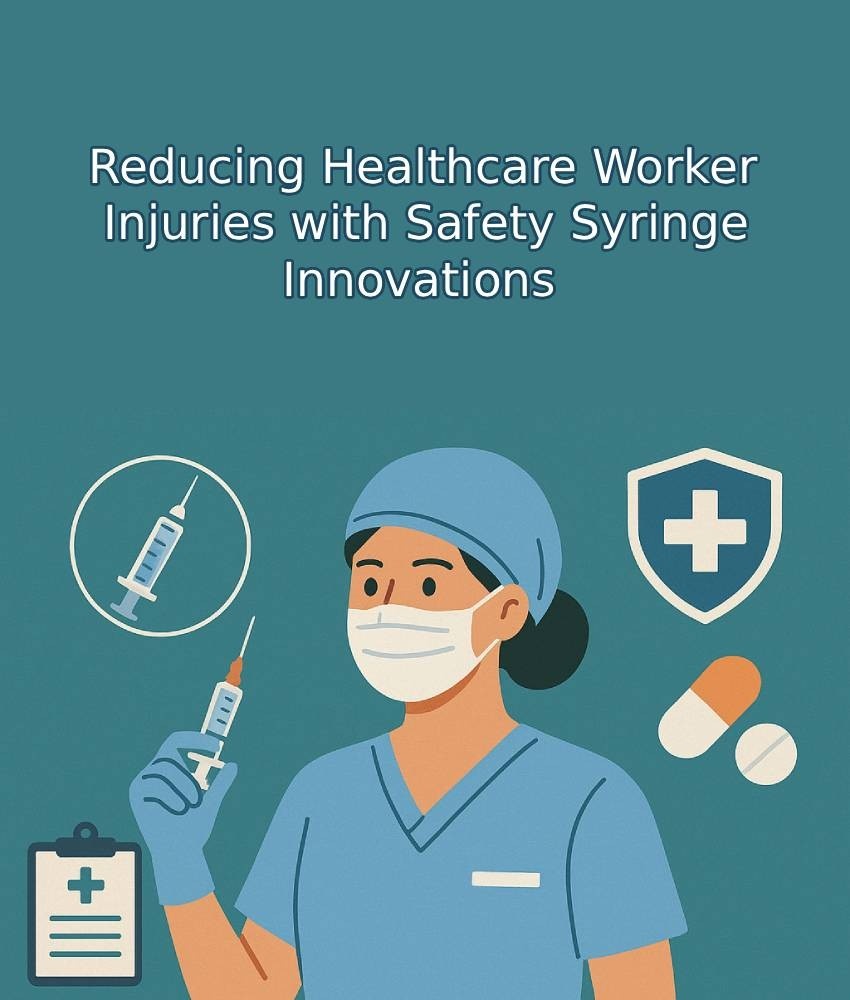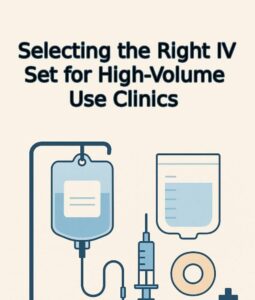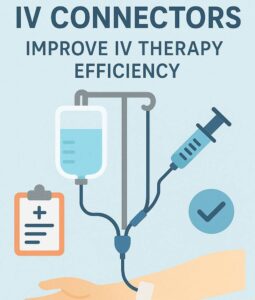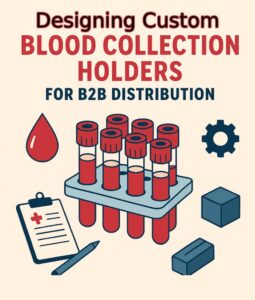Healthcare worker safety, medical device injury prevention, and the growing demand for B2B safety syringe solutions are shaping the future of patient care. With thousands of needlestick injuries occurring annually, healthcare organizations are turning to advanced safety syringes to protect their teams and reduce operational risks. Know more..
Introduction to the Safety Challenge in Healthcare Settings
Importance of Healthcare Worker Safety
Healthcare professionals face numerous occupational hazards, but few are as concerning as injuries from medical sharps. Ensuring healthcare worker safety is not just an ethical obligation—it is also crucial for operational efficiency and patient outcomes.
Consequences of Medical Device-Related Injuries
A single needlestick injury can expose workers to life-threatening infections such as HIV, Hepatitis B, and C. Beyond physical harm, there’s the mental stress and financial cost associated with treatment, legal claims, and staffing shortages.
Understanding the Risks: Common Needle-Related Injuries
Needlestick Injuries Explained
Needlestick injuries occur when a used needle punctures a healthcare worker’s skin, potentially transmitting dangerous pathogens. These incidents often happen during or after injections, blood draws, or when disposing of syringes.
Statistics on Healthcare Worker Injury Rates
According to the CDC, over 385,000 needlestick injuries occur annually in the U.S. alone. Global numbers are even more staggering, highlighting an urgent need for medical device injury prevention on a global scale.
The Role of Safety Syringes in Medical Device Injury Prevention
What Are Safety Syringes?
Safety syringes are engineered to prevent accidental needle injuries by incorporating protective mechanisms. These include retractable needles, automatic locks, and needle shields that activate post-use.
Evolution of Syringe Design for Safety
From manually capped syringes to auto-disable systems, the evolution reflects growing emphasis on healthcare worker safety and reduced exposure to bloodborne pathogens.
Innovative Safety Syringe Technologies Reducing Risk
Auto-disable Mechanisms
Auto-disable syringes prevent reuse by locking after a single injection. This not only protects workers but also combats disease transmission in regions where reuse is common.
Retractable Needle Technologies
These syringes automatically retract the needle into the barrel, preventing post-use exposure. They are considered one of the most reliable medical device injury prevention tools.
Passive vs Active Safety Systems
Passive systems activate automatically, reducing user error. Active systems require manual action but allow flexibility. Both types contribute to a safer clinical environment.
Impact of Safety Syringes on Healthcare Worker Safety
Reducing Occupational Exposure
Facilities that implemented B2B safety syringe solutions have seen up to a 70% drop in needlestick incidents. This reduces absenteeism and workers’ compensation claims.
Psychological Benefits for Healthcare Professionals
Knowing that their workplace prioritizes safety fosters confidence, reduces anxiety, and boosts morale among healthcare staff.
Market Trends in B2B Safety Syringe Development
Global Adoption of B2B Safety Syringe Models
The global market for safety syringes is expected to exceed $12 billion by 2030. This growth is fueled by rising awareness of healthcare worker safety and increased investments from hospitals and B2B procurement teams.
Regulatory Standards and Demand Drivers
Regulations like OSHA’s Bloodborne Pathogens Standard and WHO’s injection safety policies mandate the use of engineered sharps injury protections, accelerating demand.
Comparative Benefits of Safety Syringes Over Traditional Syringes
Cost-Effectiveness and Waste Reduction
Though safety syringes may cost more upfront, the savings from reduced injuries, insurance premiums, and compliance penalties make them a cost-effective solution.
Compliance and Risk Mitigation
Using FDA- and ISO-approved B2B safety syringe products helps institutions stay compliant and avoid costly legal issues related to worker injury claims.
Challenges in Implementing Safety Syringe Protocols
Training and Education
Successful adoption requires thorough training. Staff must be comfortable using the new devices, which might differ slightly from traditional tools.
Resistance to Change in Medical Institutions
Some institutions hesitate due to budget concerns or workflow disruptions. However, education and ROI data often help overcome these barriers.
Success Stories from Hospitals and Healthcare Networks
Case Study: U.S. Hospital System Deployment
A large hospital network in California reduced sharps injuries by 82% within 12 months after rolling out a custom B2B safety syringe program.
European B2B Safety Syringe Partnership
In the EU, collaborative efforts between device manufacturers and government health agencies have led to safer hospitals and national policy changes.
The Business Case for Investing in B2B Safety Syringes
ROI on Injury Prevention
Every prevented injury saves up to $3,000 in direct costs. For large institutions, that equates to millions in annual savings.
Long-Term Operational Benefits
Beyond finances, adopting safety devices enhances institutional reputation, staff retention, and accreditation outcomes.
Best Practices for Integrating Safety Syringes in Clinical Workflows
Procurement and Supply Chain Tips
Choose suppliers who specialize in customizable B2B safety syringe systems, and ensure consistent availability through smart inventory planning.
Engaging Healthcare Teams for Smooth Rollout
Involve frontline workers in pilot tests and feedback loops. Their buy-in is critical for successful implementation.
Future Outlook: What’s Next for Safety Syringe Innovations
Integration with Smart Medical Devices
Safety syringes integrated with smart tech (RFID, auto-logging) will streamline data collection and enhance oversight.
Sustainability and Eco-Friendly Designs
Innovators are developing biodegradable safety syringes to address environmental concerns without compromising healthcare worker safety.
Expert Opinions and Industry Leader Insights
Interviews with Medical Device Innovators
Dr. M. Patel, R&D Head at MedSecure Devices, shares, “Today’s safety syringe tech isn’t just about avoiding harm—it’s about building smarter, more responsive care systems.”
Quotes from Healthcare Workers on the Ground
“A safety syringe saved me from what could’ve been a disastrous mistake,” says Julia, an ICU nurse in New York. “It gives peace of mind.”
How to Choose the Right Safety Syringe for Your Facility
Checklist for Buyers
- Regulatory compliance (OSHA, CE, FDA)
- Needle retraction or shielding features
- Customization for specialty procedures
- Supplier reliability and support
Evaluating B2B Medical Device Suppliers
Look for experience, technical support, and positive reviews from other healthcare facilities when choosing a B2B safety syringe vendor.
Regulatory Compliance and Legal Considerations
OSHA and WHO Guidelines
These agencies mandate safety-engineered devices where exposure risk exists, making compliance non-negotiable.
Protecting Institutions from Liability
Failure to protect staff from preventable harm can lead to legal action, reputational damage, and hefty fines.
FAQs About Safety Syringes and Injury Prevention
Q1: How do safety syringes reduce needlestick injuries?
They retract or shield the needle automatically after use, preventing accidental contact.
Q2: Are B2B safety syringe systems customizable?
Yes, many suppliers offer tailored solutions for different clinical specialties.
Q3: What is the most effective injury prevention syringe design?
Retractable needle designs are currently the most reliable and widely used.
Q4: Is training required for safety syringe use?
Minimal training is needed, but orientation sessions improve compliance and comfort.
Q5: Are safety syringes more expensive?
Initially, yes—but they save money long-term by preventing injuries and fines.
Q6: Can safety syringes help with infection control protocols?
Absolutely. They minimize cross-contamination and support broader infection control efforts.
Conclusion: Building a Safer Future for Healthcare Workers
Medical device injury prevention isn’t optional—it’s a necessity. By adopting the latest B2B safety syringe solutions, healthcare institutions not only enhance healthcare worker safety but also safeguard their operations, legal standing, and public trust. Safety doesn’t start with policy; it begins with innovation.






